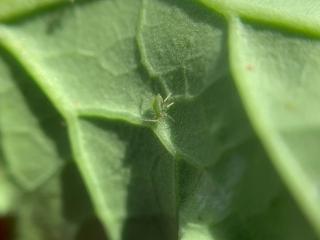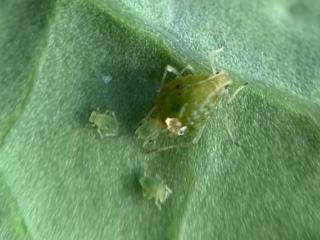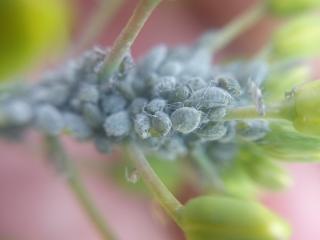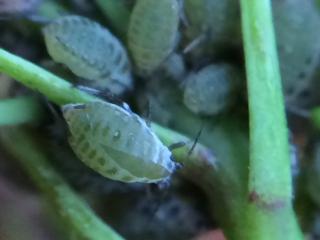Green peach aphids are appearing in canola
- Beverley
Entomologist Dusty Severtson (DPIRD) has reported finding low numbers of Green peach aphids (GPA) on crop edges of 4 leaf canola crops west of Beverley.
Crops early in the season tend to outgrow aphid damage particularly if there are good growing conditions. The cooler the weather the slower the lifecycle of the aphid and the less offspring they produce.
Before deciding to spray, consider identifying the aphid culprit. Three aphid species commonly attack canola in Western Australia: cabbage aphid, turnip aphid and GPA.
Cabbage aphids form dense bluish grey colonies covered with fine whitish powder on flowering heads in spring. They also establish on crowns and under leaves in the vegetative phase. Infestations usually first appear as 'hotspots' along the edge of crops in the paddock. The adult aphid is dull or greyish-green. GRDC recently released a Managing cabbage aphid video.
Turnip aphids infest canola crops in a similar way to cabbage aphids, usually first appearing along crop edges. Aphids have a light waxy coating, which is not as pronounced as the powdery cover of the cabbage aphid. Adults are olive to greyish green, usually with dark bars on the abdomen.
GPA occur on the underside of canola leaves of young plants and tend to be more evenly distributed in the paddock. The GPA varies in colour from shiny pale yellow-green to mid-green, orange or pink.
GPA has a wide host range, including oilseeds, lupins, pulse crops and some broadleaf pastures. Other hosts include capeweed, marshmallow, wild radish, wild turnip, Lincoln weed and other cruciferous weeds. GPA is an important vector of a number of plant viruses including turnip yellows virus (TuYV), cauliflower mosaic virus (CaMV), turnip mosaic virus (TuMV) and cucumber mosaic virus (CMV), all of which damage canola.
If you do identify GPA in your crop, monitor and only spray if seedling crops are moisture stressed and/or have high numbers of GPA on the plant so the plant is unable to outgrow GPA feeding damage. Aphid activity will slow down if cold and wet weather conditions are experienced.
Australian GPA populations are known to have resistance to four different chemical groups – synthetic pyrethroids (for example, alpha-cypermethrin), organophosphates (for example, dimethoate), carbamates (for example, pirimicarb) and neonicotinoids. Recently evidence of the green peach aphid (Myzus persicae, GPA) developing metabolic resistance to sulfoxaflor (Transform™) has been confirmed for the first time in Australia, after a small number of aphid populations from Esperance were shown to have reduced sensitivity to the insecticide. For more information see the 2019 PestFax Issue 5 article First signs of low-level resistance evolving to Transform™ detected in isolated WA green peach aphid populations .
To limit the spread and curb the further evolution of resistance, it is critical that sulfoxaflor (Transform®) is used judiciously and as part of a sound insecticide resistance management strategy. For more information refer to GRDC’s Resistance Management Strategy for the Green Peach Aphid in Australia Grains.
Growers are asked to keep a close eye on establishing canola crops this year and to contact cesar on +61 (0)3 9349 4723 if aphids survive a Transform™ application.
For a list of insecticides registered for use on insect pests in canola see DPIRD’s 2019 Autumn/Winter Insecticide Guide.
For more information on identifying and managing canola aphids refer to the DPIRD’s;
- Aphid management in canola crops page
- Diagnosing canola aphids page
- 2017 Protecting WA Crops Issue 3 newsletter Aphids – WA’s insect problem children
- Aphids in your crops YouTube video.
For more information on aphids contact Dustin Severtson, Development Officer, Northam on +61 (0)8 9690 2160 or Svetlana Micic, Research Officer, Albany on +61 (0)8 9892 8591 or Alan Lord, Technical Officer, South Perth on +61 (0)8 9368 3758.




